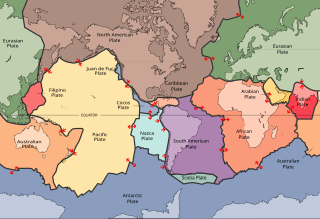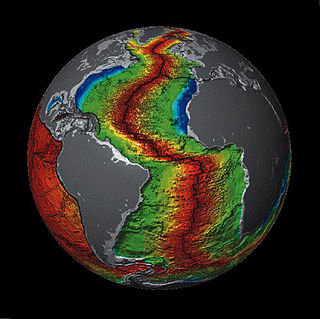Related Research Articles

Plate tectonics is the scientific theory that Earth's lithosphere comprises a number of large tectonic plates, which have been slowly moving since about 3.4 billion years ago. The model builds on the concept of continental drift, an idea developed during the first decades of the 20th century. Plate tectonics came to be accepted by geoscientists after seafloor spreading was validated in the mid-to-late 1960s.

In geology, the crust is the outermost solid shell of a rocky planet, dwarf planet, or natural satellite. It is usually distinguished from the underlying mantle by its chemical makeup; however, in the case of icy satellites, it may be distinguished based on its phase.

A lithosphere is the rigid, outermost rocky shell of a terrestrial planet or natural satellite. On Earth, it is composed of the crust and the lithospheric mantle, the topmost portion of the upper mantle that behaves elastically on time scales of up to thousands of years or more. The crust and upper mantle are distinguished on the basis of chemistry and mineralogy.

Subduction is a geological process in which the oceanic lithosphere and some continental lithosphere is recycled into the Earth's mantle at convergent boundaries. Where the oceanic lithosphere of a tectonic plate converges with the less dense lithosphere of a second plate, the heavier plate dives beneath the second plate and sinks into the mantle. A region where this process occurs is known as a subduction zone, and its surface expression is known as an arc-trench complex. The process of subduction has created most of the Earth's continental crust. Rates of subduction are typically measured in centimeters per year, with rates of convergence as high as 11 cm/year.

Sedimentary basins are region-scale depressions of the Earth's crust where subsidence has occurred and a thick sequence of sediments have accumulated to form a large three-dimensional body of sedimentary rock. They form when long-term subsidence creates a regional depression that provides accommodation space for accumulation of sediments. Over millions or tens or hundreds of millions of years the deposition of sediment, primarily gravity-driven transportation of water-borne eroded material, acts to fill the depression. As the sediments are buried, they are subject to increasing pressure and begin the processes of compaction and lithification that transform them into sedimentary rock.

Tectonics are the processes that result in the structure and properties of the Earth's crust and its evolution through time.

In planetary astronomy and astrobiology, the Rare Earth hypothesis argues that the origin of life and the evolution of biological complexity such as sexually reproducing, multicellular organisms on Earth required an improbable combination of astrophysical and geological events and circumstances.

Oceanic crust is the uppermost layer of the oceanic portion of the tectonic plates. It is composed of the upper oceanic crust, with pillow lavas and a dike complex, and the lower oceanic crust, composed of troctolite, gabbro and ultramafic cumulates. The crust overlies the rigid uppermost layer of the mantle. The crust and the rigid upper mantle layer together constitute oceanic lithosphere.

Earth's mantle is a layer of silicate rock between the crust and the outer core. It has a mass of 4.01×1024 kg (8.84×1024 lb) and thus makes up 67% of the mass of Earth. It has a thickness of 2,900 kilometers (1,800 mi) making up about 46% of Earth's radius and 84% of Earth's volume. It is predominantly solid but, on geologic time scales, it behaves as a viscous fluid, sometimes described as having the consistency of caramel. Partial melting of the mantle at mid-ocean ridges produces oceanic crust, and partial melting of the mantle at subduction zones produces continental crust.

Earth's crust is its thick outer shell of rock, referring to less than 1% of the planets radius and volume. It is the top component of the lithosphere, a division of Earth's layers that includes the crust and the upper part of the mantle. The lithosphere is broken into tectonic plates whose motion allows heat to escape the interior of the Earth into space.

Planetary habitability is the measure of a planet's or a natural satellite's potential to develop and maintain environments hospitable to life. Life may be generated directly on a planet or satellite endogenously or be transferred to it from another body, through a hypothetical process known as panspermia. Environments do not need to contain life to be considered habitable nor are accepted habitable zones (HZ) the only areas in which life might arise.

A Super-Earth is a type of exoplanet with a mass higher than Earth's, but substantially below those of the Solar System's ice giants, Uranus and Neptune, which are 14.5 and 17 times Earth's, respectively. The term "super-Earth" refers only to the mass of the planet, and so does not imply anything about the surface conditions or habitability. The alternative term "gas dwarfs" may be more accurate for those at the higher end of the mass scale, although "mini-Neptunes" is a more common term.
A river anticline is a geologic structure that is formed by the focused uplift of rock caused by high erosion rates from large rivers relative to the surrounding areas. An anticline is a fold that is concave down, whose limbs are dipping away from its axis, and whose oldest units are in the middle of the fold. These features form in a number of structural settings. In the case of river anticlines, they form due to high erosion rates, usually in orogenic settings. In a mountain building setting, like that of the Himalaya or the Andes, erosion rates are high and the river anticline's fold axis will trend parallel to a major river. When river anticlines form, they have a zone of uplift between 50-80 kilometers wide along the rivers that form them.

The discovery of extrasolar Earth-sized planets has encouraged research into their potential for habitability. One of the generally agreed requirements for a life-sustaining planet is a mobile, fractured lithosphere cyclically recycled into a vigorously convecting mantle, in a process commonly known as plate tectonics. Plate tectonics provide a means of geochemical regulation of atmospheric particulates, as well as removal of carbon from the atmosphere. This prevents a “runaway greenhouse” effect that can result in inhospitable surface temperatures and vaporization of liquid surface water. Planetary scientists have not reached a consensus on whether Earth-like exoplanets have plate tectonics, but it is widely thought that the likelihood of plate tectonics on an Earth-like exoplanet is a function of planetary radius, initial temperature upon coalescence, insolation, and presence or absence of liquid-phase surface water.

A superhabitable planet is a hypothetical type of exoplanet or exomoon that may be better suited than Earth for the emergence and evolution of life. The concept was introduced in 2014 by René Heller and John Armstrong, who have criticized the language used in the search for habitable planets and proposed clarifications. According to Heller and Armstrong, knowing whether or not a planet is in its host star's habitable zone (HZ) is insufficient to determine its habitability: It is not clear why Earth should offer the most suitable physicochemical parameters to living organisms, as "planets could be non-Earth-like, yet offer more suitable conditions for the emergence and evolution of life than Earth did or does." While still assuming that life requires water, they hypothesize that Earth may not represent the optimal planetary habitability conditions for maximum biodiversity; in other words, they define a superhabitable world as a terrestrial planet or moon that could support more diverse flora and fauna than there are on Earth, as it would empirically show that its environment is more hospitable to life.

Earth's crustal evolution involves the formation, destruction and renewal of the rocky outer shell at that planet's surface.
Heat-pipe tectonics is a cooling mode of terrestrial planets and moons in which the main heat transport mechanism in the planet is volcanism through the outer hard shell, also called the lithosphere. Heat-pipe tectonics initiates when volcanism becomes the dominant surface heat transfer process. Melted rocks and other more volatile planetary materials are transferred from the mantle to surface via localised vents. Melts cool down and solidify forming layers of cool volcanic materials. Newly erupted materials deposit on top of and bury older layers. The accumulation of volcanic layers on the shell and the corresponding evacuation of materials at depth cause the downward transfer of superficial materials such that the shell materials continuously descend toward the planet's interior.
Diana Valencia is a Colombian planetary scientist and astrophysicist. She is an associate professor of Physics and Astrophysics, University of Toronto, Scarborough, and of Astronomy & Astrophysics, University of Toronto.

Over the years, our ability to detect, confirm, and characterize exoplanets and their atmospheres has improved, allowing researchers to begin constraining exoplanet interior composition and structure. While most exoplanet science is focused on exoplanetary atmospheric environments, the mass and radius of a planet can tell us about a planet's density, and hence, its internal processes. The internal processes of a planet are partly responsible for its atmosphere, and so they are also a determining factor in a planet's capacity to support life.
References
- 1 2 3 Gough, Evan (2021-11-18). "Eggshell Planets Have a Thin Brittle Crust and No Mountains or Tectonics". Universe Today. Retrieved 2023-08-08.
- 1 2 "Eggshell Exoplanets: Rocky Worlds with Ultra-Thin Brittle Lithospheres Could Theoretically Exist | Sci.News". Sci.News: Breaking Science News. 2021-11-11. Retrieved 2023-08-08.
- 1 2 "'Eggshell Planets' -- Earth-like exoplanets orbiting distant stars". Brighter Side News. 2021-11-11. Retrieved 2023-08-08.
- 1 2 3 Ogliore, Talia (2021-11-11). "'Eggshell planets' are probably not right for life". Futurity. Retrieved 2023-08-08.
- ↑ "Scientists discover 'eggshell' planets with brittle crust and smooth exteriors". Rapid City Journal. 2021-11-15. Retrieved 2023-08-08.
- ↑ https://agupubs.onlinelibrary.wiley.com/doi/epdf/10.1029/2021JE006952
- 1 2 3 Q. Choi, Charles (2021-11-29). "Strange 'eggshell' exoplanets may have ultra-smooth surfaces". Space.com. Retrieved 2023-08-08.
- 1 2 3 Starr, Michelle (2021-11-15). "These Strange, Brittle 'Eggshell' Exoplanets Could Be Orbiting Alien Stars". ScienceAlert. Retrieved 2023-08-08.
- ↑ "Bizarre, brittle exoplanets could feel like walking on alien eggshells". SYFY Official Site. 2021-11-17. Retrieved 2023-08-08.
